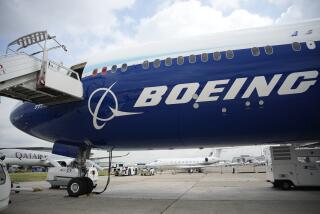Lockheed Faces $35-Million Loss in Third Quarter : Firm to Write Off Several of Its Major Fixed-Price Development Programs
- Share via
Lockheed disclosed Monday that it will take a $165-million writeoff against several major defense programs, resulting in a $35-million net loss in its third quarter and depressing further its already weak earnings this year.
The charge could increase the volatility of the situation involving Dallas investor Harold C. Simmons, who has acquired 10.4% of Lockheed shares over the past year. Simmons has said he may decide to seek control of the aerospace firm, though he has disclosed no plans to do so.
It appeared that Lockheed had decided to take the writeoffs against many of its ailing fixed-price contracts at once, following an internal review that was completed recently.
Other Programs Involved
Lockheed is just the latest aerospace firm to be hit by multimillion-dollar writeoffs on controversial contracts in which a company agrees to design and develop a weapon for a fixed amount of money, rather than receiving funding that covers all of its costs. Although the Pentagon has attempted to phase out fixed-price contracts, dozens remain in the contracting pipeline and have saddled the industry with hundreds of millions of dollars in losses.
“Lockheed does not intend to pursue any future fixed-priced development contracts,” Lockheed Chairman Daniel M. Tellep said in a statement. He said the $165-million writeoff is the result of problems on programs including building the wings for the C-17 Air Force cargo jet and modifications to the Navy EP-3E aircraft.
The Calabasas-based aerospace firm also referred to an undisclosed number of other programs on which the company took writeoffs, some of which are classified, a spokesman said. However, the bulk of the $165-million total applied to the C-17 and EP-3E programs.
“This is a big writeoff,” Paine Webber defense industry analyst Joseph Campbell said. “It adds more fuel to what Simmons is doing.”
Campbell noted that even without the writeoff, Lockheed earnings would have been below Wall Street’s expectations. According to Campbell’s analysis, the company would have earned $1.21 a share in the third quarter without the writeoff, while analysts had been expecting $1.35 a share.
Moreover, the magnitude of the writeoff increases the difficulty that many investors are having in evaluating aerospace stocks, Campbell said. Lockheed shares have gained 20.6% this year, outpacing those of most aerospace companies.
The appreciation has resulted from Simmons’ buying activities. “People suspect that Harold Simmons knows something we don’t know,” Campbell said.
Lockheed won a fixed-price subcontract in May, 1987, to produce the wings for the C-17 jet, an award worth an estimated $1.3 billion. The work is being done at Lockheed’s Georgia aircraft facility.
A Lockheed statement blamed the C-17 cost overruns, as well as those on the Navy EP-3E aircraft, on “hundreds of design changes because of continued development activity by the customers.”
McDonnell Douglas is prime contractor for the C-17 and has been attempting to reduce the weight of the aircraft to meet contract specifications. The weight-trimming activities, which have also caused major writeoffs at McDonnell Douglas, have resulted in a large number of engineering change-orders to subcontractors.
Lockheed said it will “continue to pursue its claims for equitable pricing adjustments under these contracts,” implying that it is seeking to recover a major portion of the writeoff from McDonnell Douglas through an administrative procedure.
Lockheed spokesman Robert Slayman added, “We would seriously consider litigation if we do not reach a mutually acceptable resolution of the claims.”
Slayman confirmed that both the C-17 and EP-3E programs are losing money. The EP-3E is a program to modify a dozen existing Navy P-3 patrol aircraft. The original contract value was $59.8 million.
Lockheed said it expects to announce third-quarter financial results late next week.
Tellep said the third-quarter charges take into account all of the firm’s major fixed-price development programs, except the Navy P-7A aircraft program. That program is so early in its development that the firm is reporting it on a break-even basis.
In the third quarter of 1988, Lockheed said it earned $123 million, or $2.07 per share, from continuing operations on sales of $2.3 billion.
More to Read
Inside the business of entertainment
The Wide Shot brings you news, analysis and insights on everything from streaming wars to production — and what it all means for the future.
You may occasionally receive promotional content from the Los Angeles Times.











